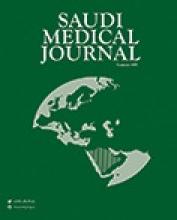Abstract
OBJECTIVE: To review the results of 137 living donor pediatric liver transplants performed at Riyadh Military Hospital (RMH).
METHODS: Retrospective analysis of the in- and out-patient case notes was carried out. Data were collected regarding age, gender, nationality, diagnosis, type of procedure, complications and survival of the grafts and the recipients.
RESULTS: The first 137 living donor pediatric liver transplants were performed in 113 months. The age range was 4.5 months to 14 years. Eighty-four recipients (61%) were male. One hundred and twelve children were Saudi. Left lateral segment was used as allograft in 135 cases. One child each received full left lobe and full right lobe. Six auxiliary partial orthotopic liver transplants were carried out. Familial metabolic liver disorders made the largest group of children needing transplant. The most common indications were progressive familial intrahepatic cholestasis and biliary atresia (45 cases each). The numbers of major complications are: hepatic artery thrombosis (n=8); portal vein thrombosis (n=3); portal vein stenosis (n=3); hepatic vein stenosis (n=3) and biliary strictures (n=4). Fifteen patients died. Three further allografts have been lost. Thus, the overall patient survival rate is 89% and graft survival rate is 86.8%.
CONCLUSION: Living donor liver transplantation is a viable option for children with end-stage liver disease. Metabolic liver disease is the most common indication in Saudi Arabia. The cadaveric donor supply is in shortage and living donation is a practical alternative. The incidence of complications and recipient and graft survival rates of the program at RMH are acceptable.
- Copyright: © Saudi Medical Journal
This is an open-access article distributed under the terms of the Creative Commons Attribution-Noncommercial-Share Alike 3.0 Unported, which permits unrestricted use, distribution, and reproduction in any medium, provided the original work is properly cited.






